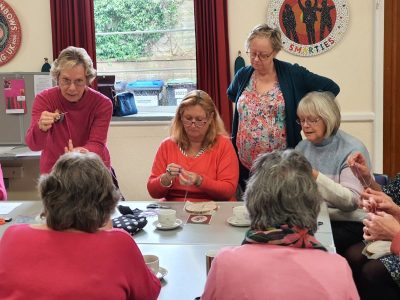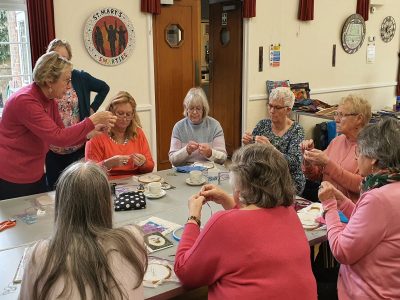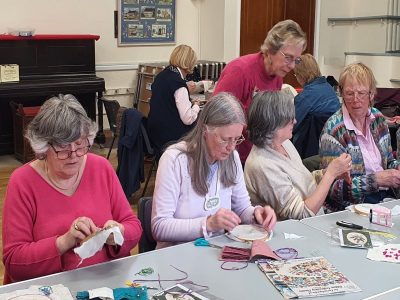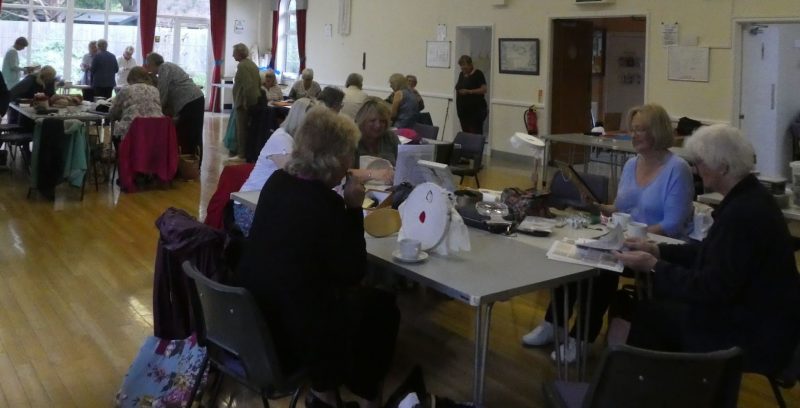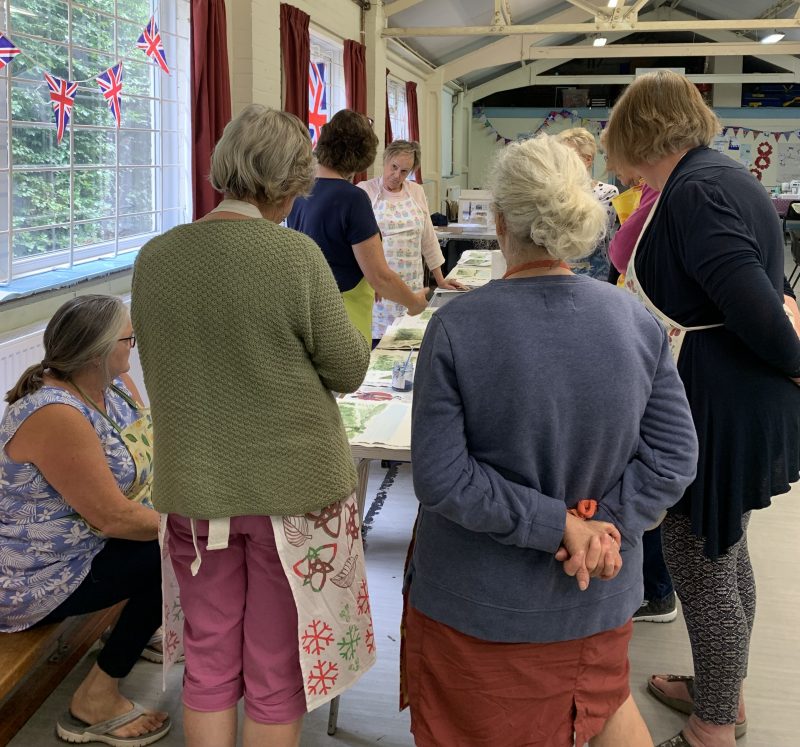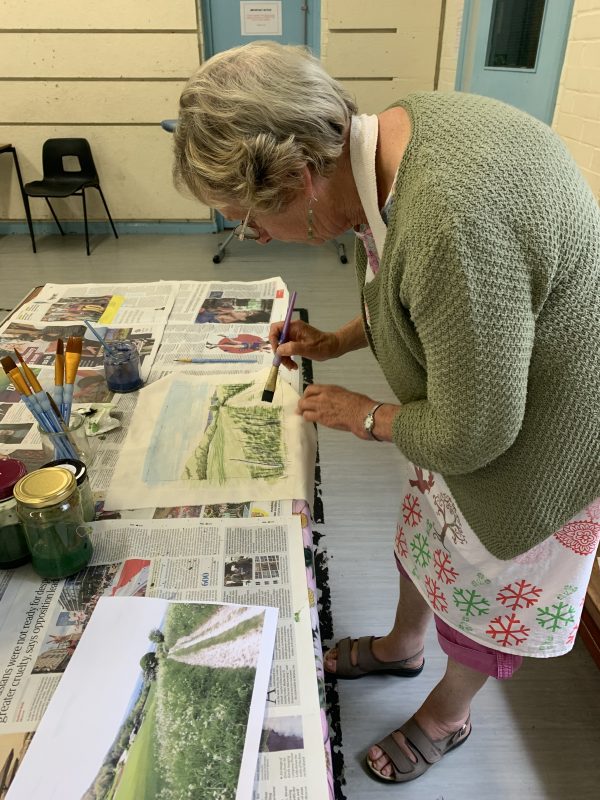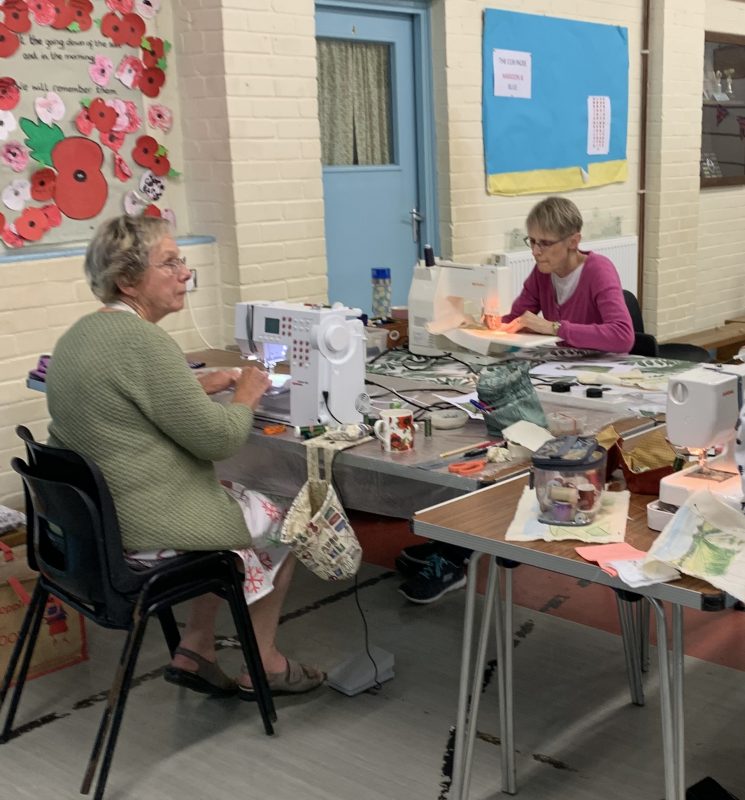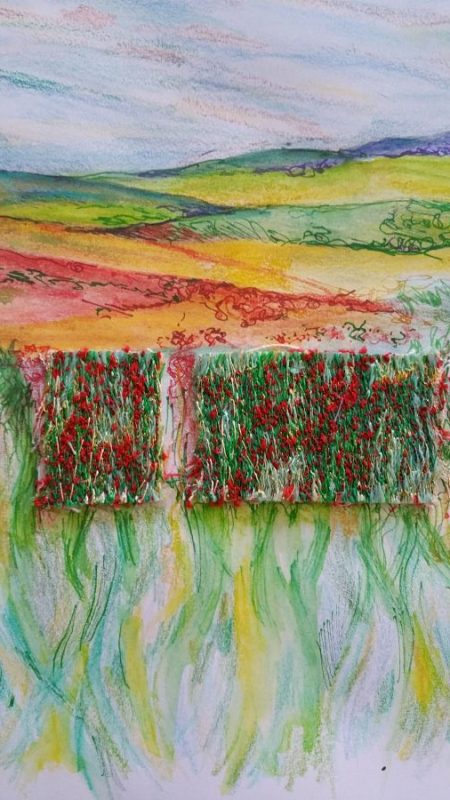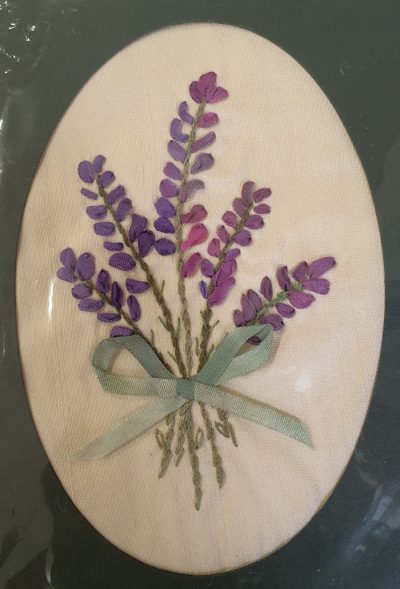 What a lovely afternoon stitching during our April sit-and-sew meeting. Jan Angove demonstrated silk-ribbon shading, and a large group of members joined her for that. Jan had hand-dyed the silk ribbon in advance, so each person’s piece will be unique. This is an example of a finished piece. There was a peaceful buzz of conversation all afternoon. Isn’t it lovely to stitch in company? There are more photos of the afternoon below. Annette reminded members that the AGM is next month, and we would like more people on the committee. It would be fine for a new committee member to join us without taking on a specific role, so that they can find out how things work before deciding if they want to take on more. One of the main things is to have new people with new ideas. The role isn’t too time-consuming; usually one committee meeting per month, and additional roles only if you want them. Don’t be put off if you’re a new member: many of us on the committee were roped in very soon after joining. We would also welcome any long-standing members who might be interested.
What a lovely afternoon stitching during our April sit-and-sew meeting. Jan Angove demonstrated silk-ribbon shading, and a large group of members joined her for that. Jan had hand-dyed the silk ribbon in advance, so each person’s piece will be unique. This is an example of a finished piece. There was a peaceful buzz of conversation all afternoon. Isn’t it lovely to stitch in company? There are more photos of the afternoon below. Annette reminded members that the AGM is next month, and we would like more people on the committee. It would be fine for a new committee member to join us without taking on a specific role, so that they can find out how things work before deciding if they want to take on more. One of the main things is to have new people with new ideas. The role isn’t too time-consuming; usually one committee meeting per month, and additional roles only if you want them. Don’t be put off if you’re a new member: many of us on the committee were roped in very soon after joining. We would also welcome any long-standing members who might be interested.
Tag: Southdowns Creative Stitchers
‘Those who understand, teach’.

Thank you to Amanda Duke for an interesting and entertaining talk at our January meeting. Amanda was an art teacher for many years and was head of art at Steyning Grammar School. The focus of her talk was debunking the claim by George Bernard Shaw that ‘Those who can, do; those who can’t, teach’. During her talk, Amanda spoke about the transition from teacher to full-time artist, and the process of building confidence in both. Amanda spoke about how fortunate she felt to have good art teaching herself as a student, and how passionate she feels about passing this on. There are quite a few teachers in our group, so there were many nodding heads as Amanda talked.

Amanda talked us through her lifetime of ‘Art Doing’ and ‘Art Teaching’. Starting with a fine art training, becoming a teacher for 36 years including being head of art; and only fairly recently (the last few years) becoming a full-time artist. Her practice has mainly been in fine art and collage, and it is mainly the last five years or so that she has become a textile artist. It was surprising (and strangely reassuring) to hear Amanda talk about Imposter Syndrome as an artist in her own right. This isn’t something that you expect to hear from someone who is art college trained, taught art for 36 years, produces such amazing work, has won a prize at the Festival of Quilts, been an exhibitor with different prestigious exhibiting groups, set up and run two large exhibitions at the FOG and other achievements. If someone feels this despite having such clearly established professional art credentials, then there is hope for the rest of us! In fact that was one of the main themes of Amanda’s talk – how to find the courage to just get on and do it, take a risk, and ‘put yourself out there’.
 Stitched textiles are a relatively new departure for Amanda, whose main interests until a few years ago had been in fine art, and paper collage. An interest in stitch and quilting began to develop when she facilitated the Steyning Grammar School Heritage Quilts. This was a project that was supported by a Heritage Lottery grant, and was a community project that brought in 500 local people of all ages. It led to setting up the ‘Steyning So and Sews’, when the group had enjoyed themselves so much that they didn’t want to stop when the project was completed.
Stitched textiles are a relatively new departure for Amanda, whose main interests until a few years ago had been in fine art, and paper collage. An interest in stitch and quilting began to develop when she facilitated the Steyning Grammar School Heritage Quilts. This was a project that was supported by a Heritage Lottery grant, and was a community project that brought in 500 local people of all ages. It led to setting up the ‘Steyning So and Sews’, when the group had enjoyed themselves so much that they didn’t want to stop when the project was completed.
 In 2014 Amanda went part-time at school and started teaching adults too. Over the last four or five years, Amanda has been increasingly drawn to fabric and stitch. Like many SCS members she did a course with Wendy Dolan, which gave her the skills to machine-embroider over her fabric collages. Being Artist in Residence at Sussex Prairie Gardens in 2017 encouraged her to think big, and she was inspired by the flowers and leaves, as well as the experience of ‘meandering’ through the paths and flower-beds. She developed techniques and skills in plant-rubbings and eco-print, which she incorporated into the exhibition.
In 2014 Amanda went part-time at school and started teaching adults too. Over the last four or five years, Amanda has been increasingly drawn to fabric and stitch. Like many SCS members she did a course with Wendy Dolan, which gave her the skills to machine-embroider over her fabric collages. Being Artist in Residence at Sussex Prairie Gardens in 2017 encouraged her to think big, and she was inspired by the flowers and leaves, as well as the experience of ‘meandering’ through the paths and flower-beds. She developed techniques and skills in plant-rubbings and eco-print, which she incorporated into the exhibition.
 Being the artist-leader on a Colouricious holiday to India threw Amanda into a full sensory experience, and in response her work moved away from the more subtle browns and greens and became a riot of colour. She moved to using Procion-dyed fabrics rather than natural-dyes, and enjoyed the vibrant colours that these produce.
Being the artist-leader on a Colouricious holiday to India threw Amanda into a full sensory experience, and in response her work moved away from the more subtle browns and greens and became a riot of colour. She moved to using Procion-dyed fabrics rather than natural-dyes, and enjoyed the vibrant colours that these produce.

Amanda joined Leslie Morgan at the Committed to Cloth studio, and felt she had found ‘her tribe’. She enjoyed the sense of purpose, productivity and play, which in turn she passes on to her own students. Unfortunately this was around the time of Covid lockdowns, so Amanda was then suddenly working on her own in her garden studio, and having to think about what direction she wanted to go in. Over time she began to draw together her two quite different styles of work – the natural dye processes and the Procion dye processes. Spending lockdown time in her garden led to realising that the reason the flower colours ‘pop’ and look so bright is that they are offset by the more neutral colours of leaves and earth. This led her to combine the two styles together.
 Having been invited to exhibit at the Festival of Quilts, Amanda found herself taking responsibility for the gallery since the founder of the group was unwell. This was a very big learning curve. At the same FOQ she also entered one of her quilts to the open competition and was delighted to win a prize (anyone who has been to the FOQ will know what an achievement this is). Amanda described the combination of excitement, nerves and achievement that this experience gave. She encouraged everyone to seize opportunities and ‘go for it’.
Having been invited to exhibit at the Festival of Quilts, Amanda found herself taking responsibility for the gallery since the founder of the group was unwell. This was a very big learning curve. At the same FOQ she also entered one of her quilts to the open competition and was delighted to win a prize (anyone who has been to the FOQ will know what an achievement this is). Amanda described the combination of excitement, nerves and achievement that this experience gave. She encouraged everyone to seize opportunities and ‘go for it’.

Amanda has largely seen off any ‘Imposter Syndrome’ now that she has been able to develop her own practice and has seen that people respond to her work. However, she is passionate about encouraging other people to learn and enjoy art and textiles, and remains a teacher at heart. She is also now able to confidently describe herself as ‘An artist’. Her story brought her talk back to the original sneer that ‘Those who can’t, teach’ and highlights the much better quote from Aristotle that ‘Those who know, do: Those who understand, teach’.
‘Open your eyes and look’
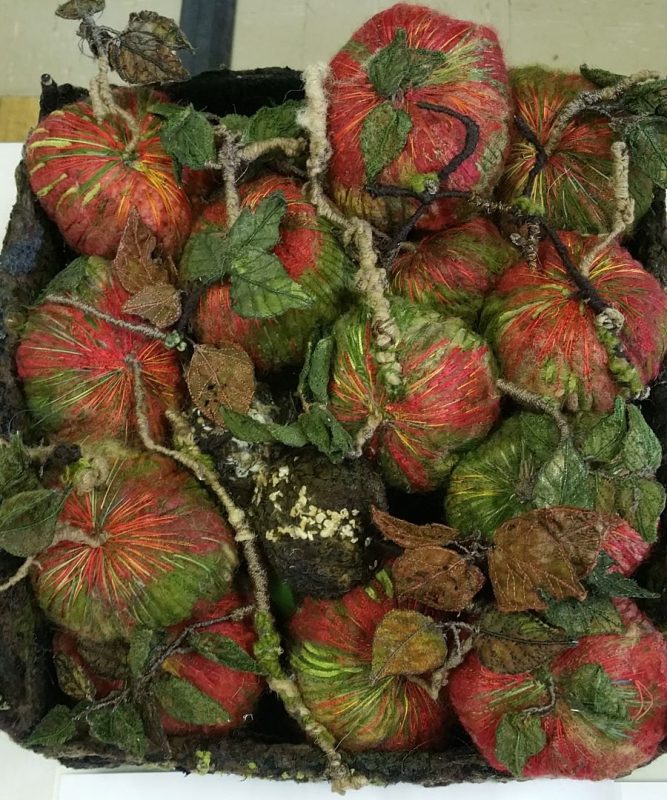 We had some very different work to look at during our November meeting, when we heard a fascinating talk by Heather Collins, textile artist. Heather brought a wonderful selection of her work to show us, and talked us through her textile journey and some of her inspirations and techniques.
We had some very different work to look at during our November meeting, when we heard a fascinating talk by Heather Collins, textile artist. Heather brought a wonderful selection of her work to show us, and talked us through her textile journey and some of her inspirations and techniques.
 Heather grew up in a creative family (her mother was accomplished at pattern-cutting and tailoring) but despite this background Heather didn’t take to needlework while she was at school. She came back to textiles in her mid-thirties, when she took a course in patchwork and joined the Brighton branch of the Embroiderers Guild. Two things added to the inspiration that she began to feel: one was doing an ‘A’ Level in Art, and the other was signing up for a machine-embroidery course with Wendy Dolan. Many of our own members have been inspired by Wendy’s teaching, so there were many understanding nods when Heather described how her interest developed. The machine-stitched cabbage above was one of the pieces that she made during this time. Heather described the experience of ‘the lid being lifted off’, so that she was able to really look and observe.
Heather grew up in a creative family (her mother was accomplished at pattern-cutting and tailoring) but despite this background Heather didn’t take to needlework while she was at school. She came back to textiles in her mid-thirties, when she took a course in patchwork and joined the Brighton branch of the Embroiderers Guild. Two things added to the inspiration that she began to feel: one was doing an ‘A’ Level in Art, and the other was signing up for a machine-embroidery course with Wendy Dolan. Many of our own members have been inspired by Wendy’s teaching, so there were many understanding nods when Heather described how her interest developed. The machine-stitched cabbage above was one of the pieces that she made during this time. Heather described the experience of ‘the lid being lifted off’, so that she was able to really look and observe.

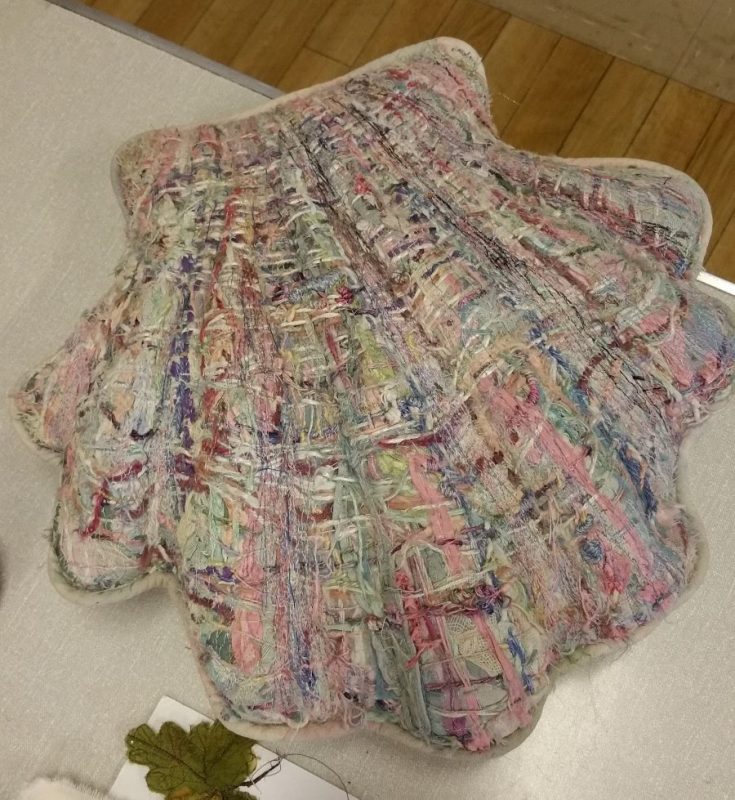 Heather began to see things with fresh eyes, and found inspiration on the natural world. She was very fortunate to do a City and Guilds Part 1 course at Windsor with Jan and Jean, which of course was an inspiring experience. She developed more skills in machine and hand embroidery, as well as observation skills.
Heather began to see things with fresh eyes, and found inspiration on the natural world. She was very fortunate to do a City and Guilds Part 1 course at Windsor with Jan and Jean, which of course was an inspiring experience. She developed more skills in machine and hand embroidery, as well as observation skills.
 Heather decided not to go on to Part 2 (Diploma) as she already had so many ideas that she wanted to pursue. Three-dimensional work became more and more of a fascination, as shown by the detail of the apples above. She shared some really helpful tips on the foundations she uses for 3D work, for example chicken wire, muslin with non-fungicidal glue, or insulation foam that can be cut to shape and covered with stitched scrim and PVA glue. Her main inspiration remained the natural world; for example vegetation, bark, shells, seaweed, wood, stones etc.
Heather decided not to go on to Part 2 (Diploma) as she already had so many ideas that she wanted to pursue. Three-dimensional work became more and more of a fascination, as shown by the detail of the apples above. She shared some really helpful tips on the foundations she uses for 3D work, for example chicken wire, muslin with non-fungicidal glue, or insulation foam that can be cut to shape and covered with stitched scrim and PVA glue. Her main inspiration remained the natural world; for example vegetation, bark, shells, seaweed, wood, stones etc.
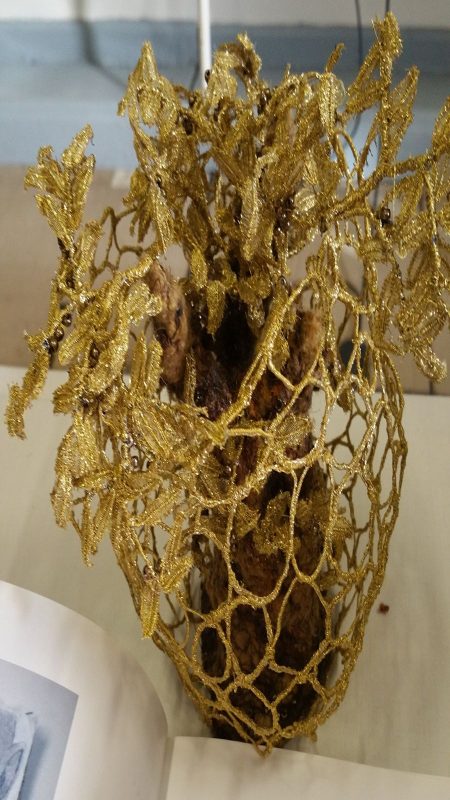 Over the years Heather has exhibited at Ramster, and Brighton Open Studios. She has also entered and been successful in a series of textile art exhibitions in France. The encased olive tree above is an example of one of her exhibits in France (it was of particular interest to the Mixed Media sub-group as we will be doing some work based on twisted wire forms in the new year).
Over the years Heather has exhibited at Ramster, and Brighton Open Studios. She has also entered and been successful in a series of textile art exhibitions in France. The encased olive tree above is an example of one of her exhibits in France (it was of particular interest to the Mixed Media sub-group as we will be doing some work based on twisted wire forms in the new year).
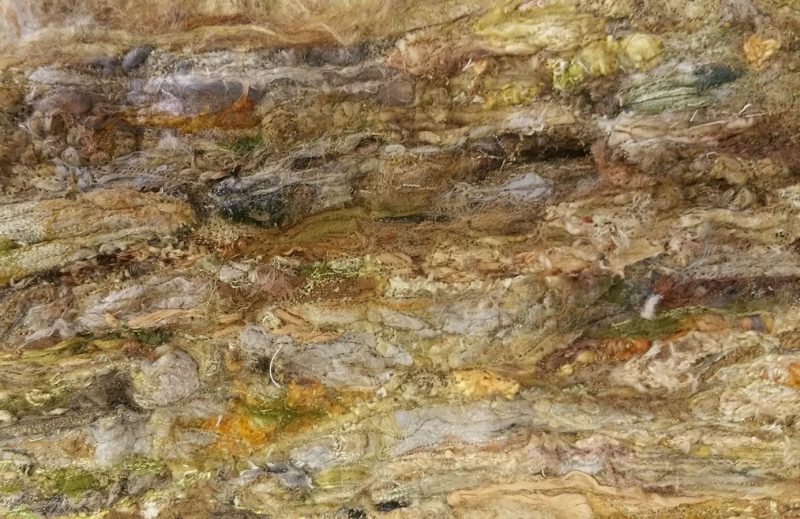
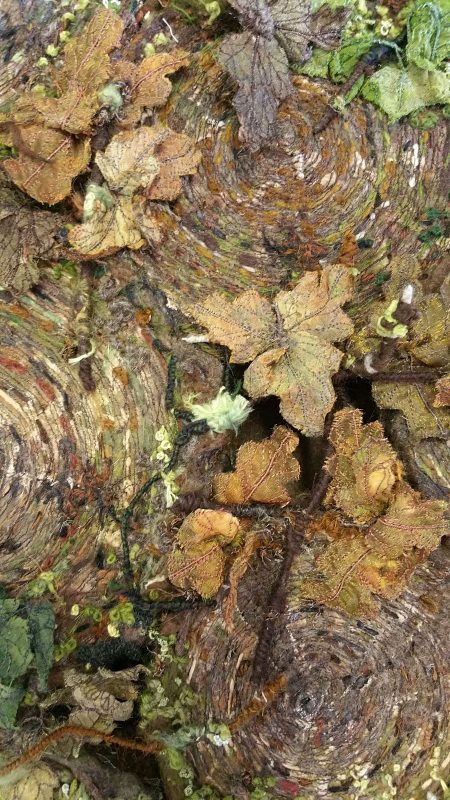 Heather’s work is built up from layer upon layer of threads and snippets, which are stitched intensively to form a background. On 3D pieces this is sometimes shaped into a ‘jacket’ that is stitched round the inner ‘former’, and the smaller details are then stitched on to that. She tends to use a limited range of stitches (straight stitch, French knots and bullion knots). When telling us about the smaller hand-stitched details that are added, Heather told us one of the funniest anecdotes that we had heard for some time. She spent several days hand-stitching lots of small mussel-shells based on chicken-wire, that that she was going to apply to a background. She left them on the coffee-table in the living room, but when she came back every one of them had disappeared…but there was no-one else in the house. The mystery was solved when she realised that her chocolate Labrador was looking rather sheepish: he had eaten them all. Luckily the dog was alright, but he cost her a big vets bill and two days work!
Heather’s work is built up from layer upon layer of threads and snippets, which are stitched intensively to form a background. On 3D pieces this is sometimes shaped into a ‘jacket’ that is stitched round the inner ‘former’, and the smaller details are then stitched on to that. She tends to use a limited range of stitches (straight stitch, French knots and bullion knots). When telling us about the smaller hand-stitched details that are added, Heather told us one of the funniest anecdotes that we had heard for some time. She spent several days hand-stitching lots of small mussel-shells based on chicken-wire, that that she was going to apply to a background. She left them on the coffee-table in the living room, but when she came back every one of them had disappeared…but there was no-one else in the house. The mystery was solved when she realised that her chocolate Labrador was looking rather sheepish: he had eaten them all. Luckily the dog was alright, but he cost her a big vets bill and two days work!
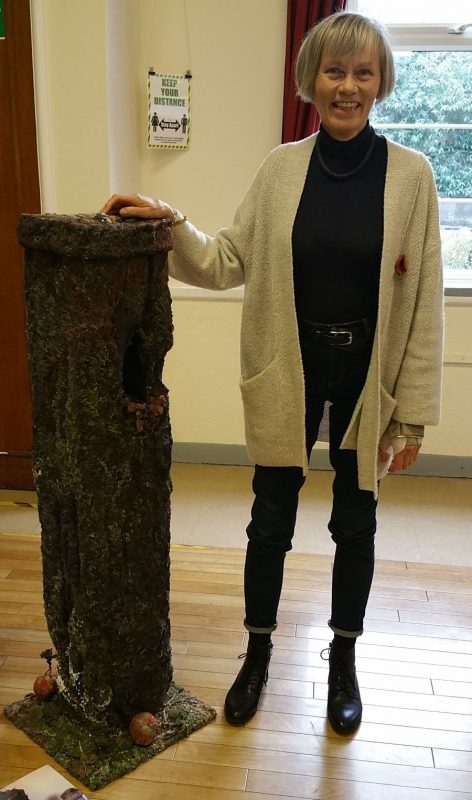 One of the fascinating things about Heather’s work is the way she combines intricate detail with large-scale work, a process that makes her work very distinctive (and time-consuming). The picture above shows Heather with one of her 3D pieces inspired by a wooden groyne (the photo doesn’t how how the surface is entirely covered in stitched detail). Sometimes people mistake her art for ‘the real thing’ and have to touch it to believe that it is hand-made.
One of the fascinating things about Heather’s work is the way she combines intricate detail with large-scale work, a process that makes her work very distinctive (and time-consuming). The picture above shows Heather with one of her 3D pieces inspired by a wooden groyne (the photo doesn’t how how the surface is entirely covered in stitched detail). Sometimes people mistake her art for ‘the real thing’ and have to touch it to believe that it is hand-made.
 One of the memorable things about Heather’s talk was her description of how stitching has helped her through difficult times in her life, and what a wonderful thing it is for mental/emotional well-being (I think we can all relate to that!) She spoke about ‘the spark’ that ignites when you really look around you and see the natural world and want to interpret it in art. Seeing how people responded to her work also showed how that ‘spark’ can be passed from one person to another.
One of the memorable things about Heather’s talk was her description of how stitching has helped her through difficult times in her life, and what a wonderful thing it is for mental/emotional well-being (I think we can all relate to that!) She spoke about ‘the spark’ that ignites when you really look around you and see the natural world and want to interpret it in art. Seeing how people responded to her work also showed how that ‘spark’ can be passed from one person to another.
Introduction to Goldwork
 There was an air of intense concentration in the Introduction to Goldwork day workshop this week. There was also some chat and laughter as well. Well done everyone for working so hard and being lovely company. Scroll down for a few more photos. For goldwork enthusiasts in the group, we have a treat coming up next year: Jenny Adin-Christie (Royal School of Needlework) will be coming to do a two-day workshop for us. Look out for details in the newsletter next year.
There was an air of intense concentration in the Introduction to Goldwork day workshop this week. There was also some chat and laughter as well. Well done everyone for working so hard and being lovely company. Scroll down for a few more photos. For goldwork enthusiasts in the group, we have a treat coming up next year: Jenny Adin-Christie (Royal School of Needlework) will be coming to do a two-day workshop for us. Look out for details in the newsletter next year. 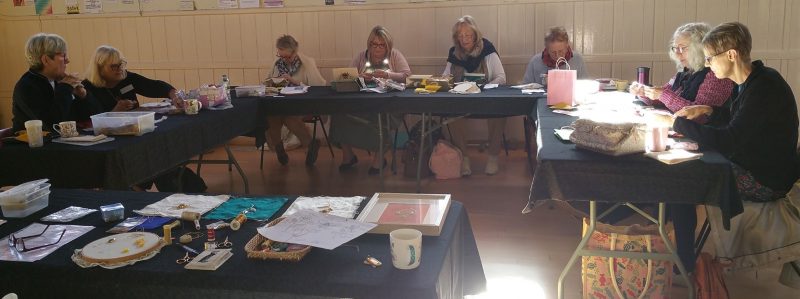

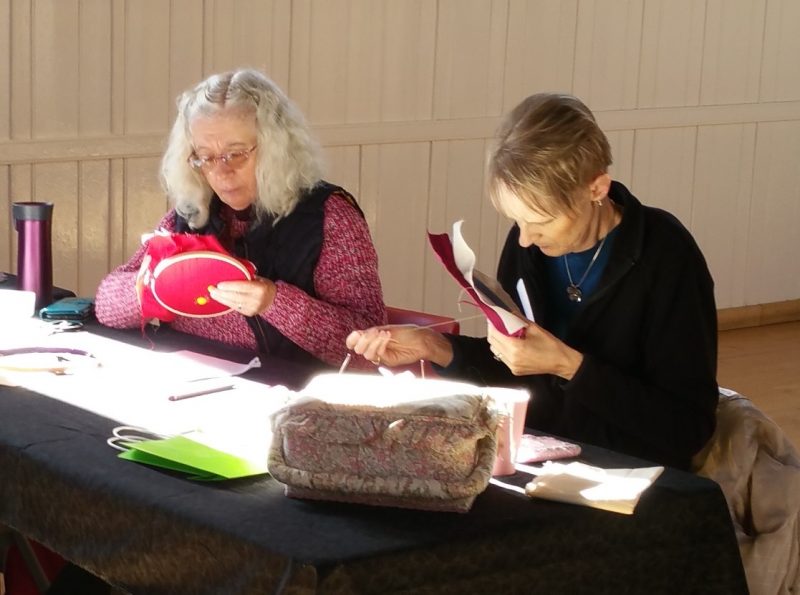




Last month’s meeting
 Thanks to Annette for sending in some photos from the September ‘sit-and-sew’. They are a bit late appearing on here as I’ve been away. I was sorry to miss the meeting, but judging by the photos it looks like a good afternoon. The photos of individual work have’t got names on them; if you would like to claim one as yours, just put a comment in the box below here and I’ll add your name.
Thanks to Annette for sending in some photos from the September ‘sit-and-sew’. They are a bit late appearing on here as I’ve been away. I was sorry to miss the meeting, but judging by the photos it looks like a good afternoon. The photos of individual work have’t got names on them; if you would like to claim one as yours, just put a comment in the box below here and I’ll add your name.


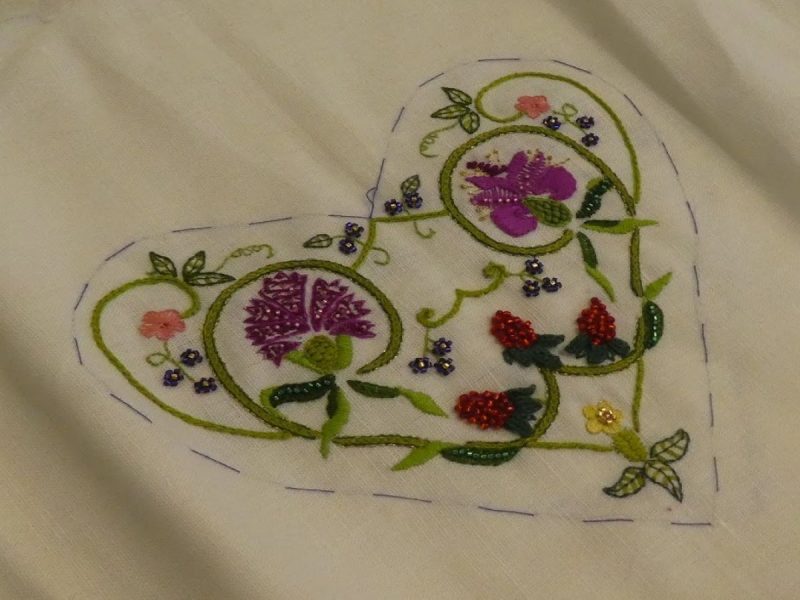
Sussex landscapes in machine embroidery

I’ve received some lovely photos from the workshop in June with Julia Brown, on Sussex landscapes in machine embroidery (thanks to Margaret for the photos). I’ve seen some wonderful creations from this day, and everyone seems to have really enjoyed it. Julia showed people how to colour the fabric ready for stitching, and while that dried she demonstrated some useful tips on machine embroidery. Julia gave everyone a pre-prepared canvas to practice stitching on while their canvas dried, and while they learned the techniques. The bigger painted canvas was taken away to complete at home. The two shown here are by Margaret, and there are also some photos of the workshop in progress. You can see the concentration!

Kim Thittichai says ‘come and play with me’.
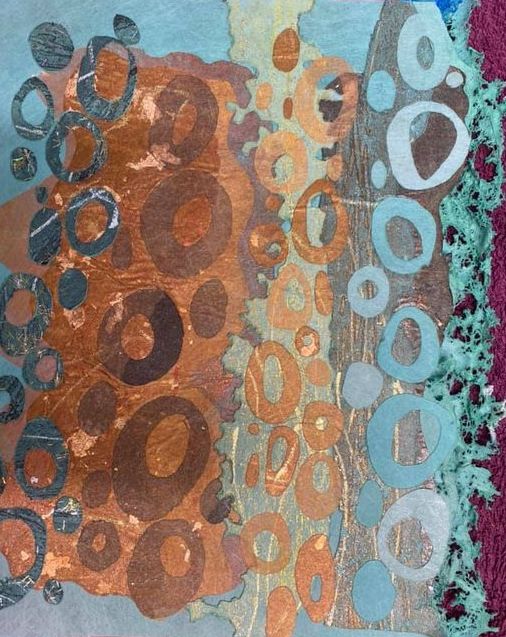 Many of our members need no introduction to Kim Thittichai, the well-known international textile artist who lived in Sussex until a few years ago. Many of us have benefited from her inspiring teaching over the years (I was very fortunate to do a year-long City and Guilds Textile Decoration course with her many moons ago, and I’m still using and enjoying techniques that I learnt from that course). Kim made an inspiring move to the South West coast of Ireland a few years ago, where she is pursuing her own textile work as well as teaching online. That brings me to the reason for this post: Kim is now offering her ‘signature’ Experimental Textiles course online. If you feel ready to take on the fun and challenge of a bigger course, there is more information in the link below. It’s a 10-month course with monthly online tuition sessions, monthly individual tutorial, monthly project, an online support group with other course members, and two years access to the 24 videos that make up the content of the course. Kim recognises that it’s a big commitment, so if you’re interested, she suggests you contact her to talk it over before deciding. Have a look at her website and you’ll see lots of inspiring images. If you’re ready for a new challenge, do consider it. I can guarantee you’ll have fun! https://www.kimthittichai.com/?utm_source=Sonas+Studio+reminder+list&utm_campaign=ba0785c435-EMAIL_CAMPAIGN_2022_07_27_07_05&utm_medium=email&utm_term=0_428c83cced-ba0785c435-334865653
Many of our members need no introduction to Kim Thittichai, the well-known international textile artist who lived in Sussex until a few years ago. Many of us have benefited from her inspiring teaching over the years (I was very fortunate to do a year-long City and Guilds Textile Decoration course with her many moons ago, and I’m still using and enjoying techniques that I learnt from that course). Kim made an inspiring move to the South West coast of Ireland a few years ago, where she is pursuing her own textile work as well as teaching online. That brings me to the reason for this post: Kim is now offering her ‘signature’ Experimental Textiles course online. If you feel ready to take on the fun and challenge of a bigger course, there is more information in the link below. It’s a 10-month course with monthly online tuition sessions, monthly individual tutorial, monthly project, an online support group with other course members, and two years access to the 24 videos that make up the content of the course. Kim recognises that it’s a big commitment, so if you’re interested, she suggests you contact her to talk it over before deciding. Have a look at her website and you’ll see lots of inspiring images. If you’re ready for a new challenge, do consider it. I can guarantee you’ll have fun! https://www.kimthittichai.com/?utm_source=Sonas+Studio+reminder+list&utm_campaign=ba0785c435-EMAIL_CAMPAIGN_2022_07_27_07_05&utm_medium=email&utm_term=0_428c83cced-ba0785c435-334865653
A passion for colour
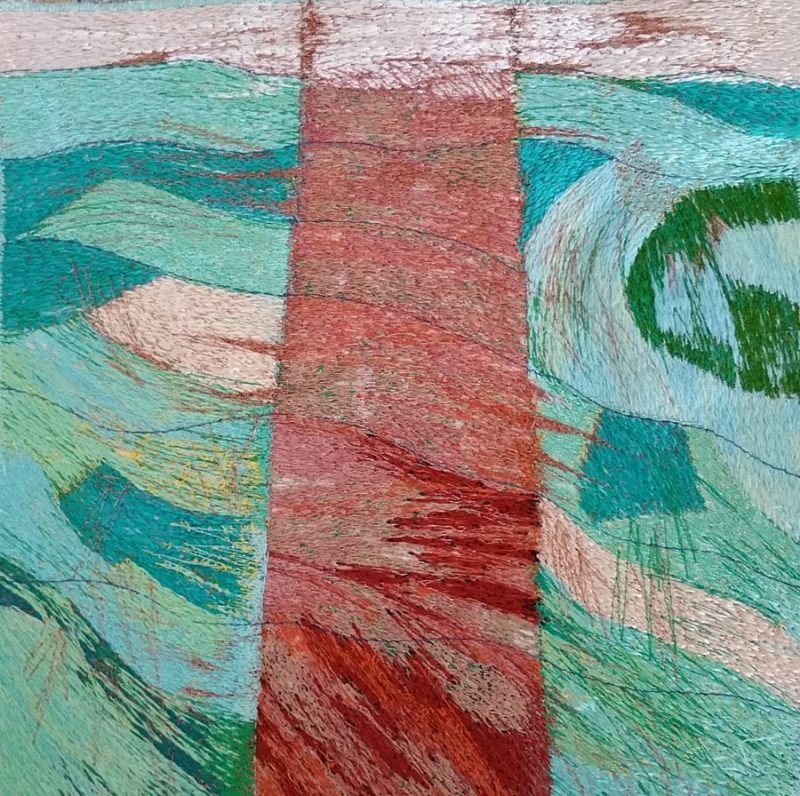 Carol Naylor was our inspiring speaker this month. Carol started by surprising us when she said that she was initially a ‘reluctant embroiderer’. She wanted to get into art college (Goldsmiths) to study painting, but was offered a place on the Goldsmiths embroidery course instead. People tried to talk her out of it. She accepted their misgivings (‘You can’t sew’, ‘You don’t like embroidery’) but she accepted the place, thinking that it would be ‘a foot in the door’ and that after a few weeks she would change to painting. Little did she know that embroidery would turn out to be a life-long passion.
Carol Naylor was our inspiring speaker this month. Carol started by surprising us when she said that she was initially a ‘reluctant embroiderer’. She wanted to get into art college (Goldsmiths) to study painting, but was offered a place on the Goldsmiths embroidery course instead. People tried to talk her out of it. She accepted their misgivings (‘You can’t sew’, ‘You don’t like embroidery’) but she accepted the place, thinking that it would be ‘a foot in the door’ and that after a few weeks she would change to painting. Little did she know that embroidery would turn out to be a life-long passion.
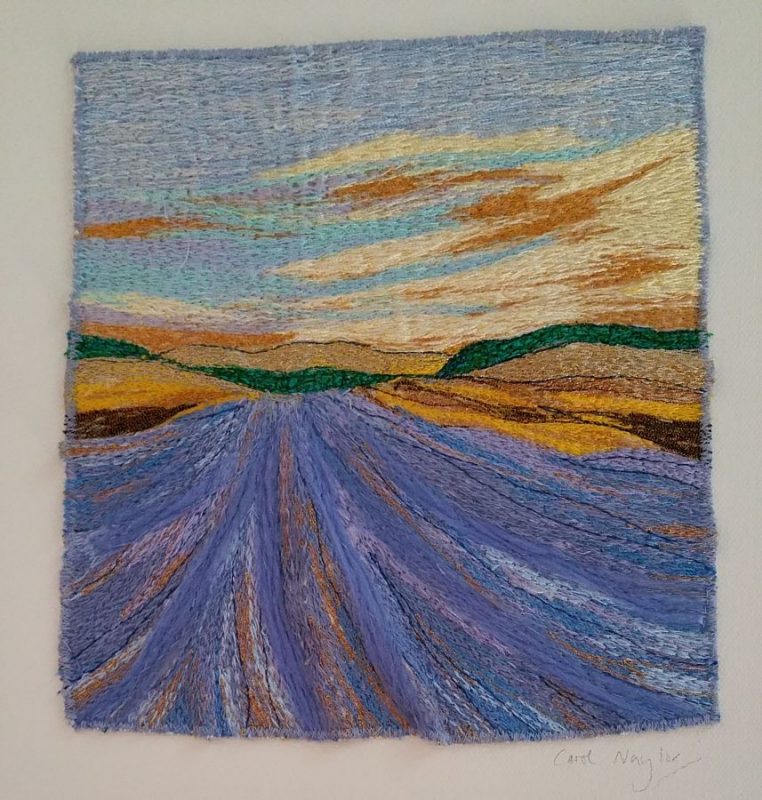 Somehow the change to painting never happened, and she found herself getting drawn into the world of stitch. Carol was lucky to be at Goldsmiths during the time when the legendary Constance Howard was teaching there. She spoke about her memories of Constance Howard’s green hair and her exacting standards. Carol struggled with embroidery for some time, but spoke about a breakthrough when Constance gave positive feedback on a small aspect of one of her pieces.
Somehow the change to painting never happened, and she found herself getting drawn into the world of stitch. Carol was lucky to be at Goldsmiths during the time when the legendary Constance Howard was teaching there. She spoke about her memories of Constance Howard’s green hair and her exacting standards. Carol struggled with embroidery for some time, but spoke about a breakthrough when Constance gave positive feedback on a small aspect of one of her pieces.
Carol’s interest in painting is self-evident in her work. From her post-graduate studies onwards, she developed her own style of ‘painting with the sewing machine’. She always creates from her own observations. She uses photos and sketchbooks as part of her preparation, but she finds it essential to have seen the subject directly. She brought sketchbooks for us to look at, and it was fascinating to see the development of a sketch, through stitch samples, and into a finished piece.
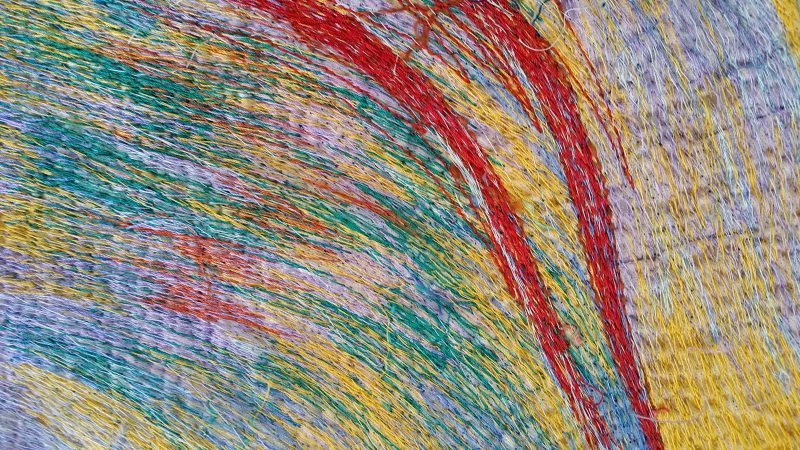
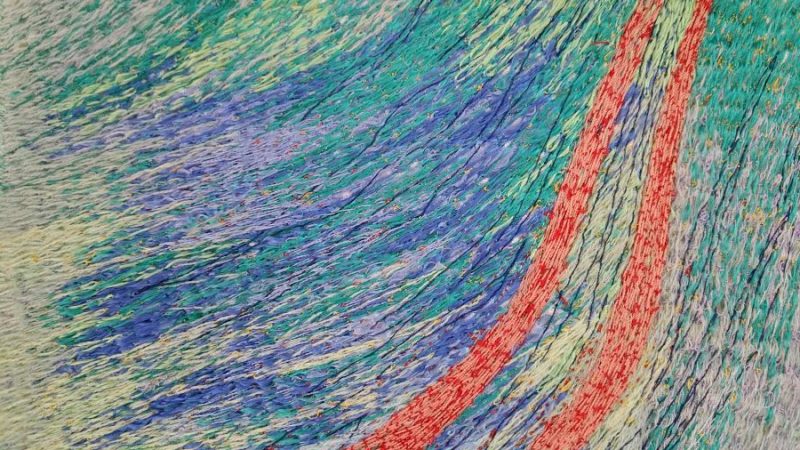 Carol works from the back of her work. The threads that she wants on the front of her work would be too thick to go through the needle, so she puts them in the bobbin and stitches ‘upside down’. The two photos above show the two sides of one of her pieces – interestingly, the back is also lovely!
Carol works from the back of her work. The threads that she wants on the front of her work would be too thick to go through the needle, so she puts them in the bobbin and stitches ‘upside down’. The two photos above show the two sides of one of her pieces – interestingly, the back is also lovely!
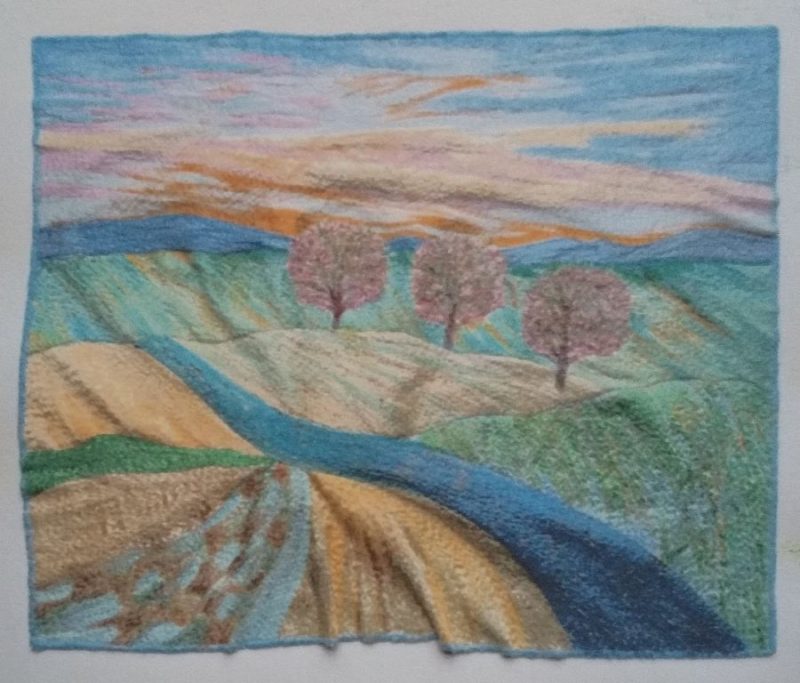 Carol ended up with a long-term career in textiles, becoming head of department at Chichester College for many years, interspersed with teaching Spanish. She eventually left the college to focus on her own work. She draws her inspiration from landscapes, with particular love of the South Downs, Italy and Spain.
Carol ended up with a long-term career in textiles, becoming head of department at Chichester College for many years, interspersed with teaching Spanish. She eventually left the college to focus on her own work. She draws her inspiration from landscapes, with particular love of the South Downs, Italy and Spain.
She spoke about how she loves to inspire other people, and also how she loves to see the work of other artists. She showed us some examples of work by other people that she admires, and talked about how different artistic disciplines can influence and inspire each other. Carol is a Fellow of the Society of Designer Craftsmen and was chairman for four years. She has work exhibited in the current exhibition at the Bankside Gallery (open now, until 26th June). She will also has work in a forthcoming exhibition at the Oxmarket Gallery in Chichester, as part of the local art group ARTEL. Each member of the group has submitted art inspired by the Chichester Ship Canal. Good timing, as the exhibition is open from Tues 21st June to Sun 3rd July, so I for one plan to go along to see it. Details in the link. https://www.oxmarket.org/exhibitions/artel-2022





